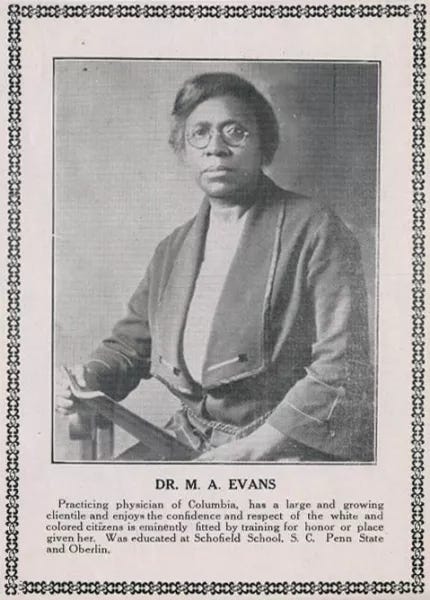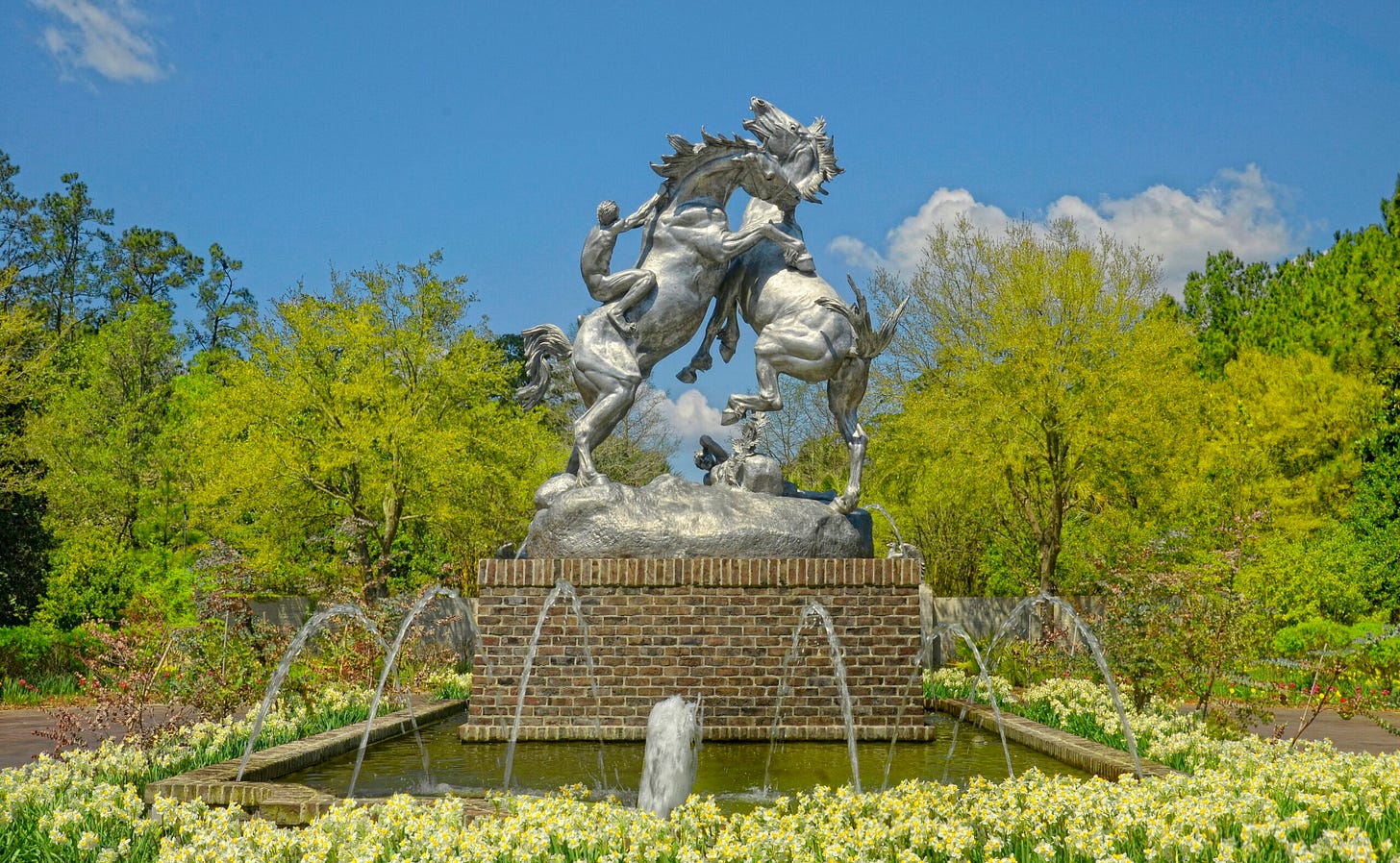#25: A groundbreaking doctor, the country's first public sculpture garden, and a Gamecocks odyssey
For South Carolina history lovers far and wide! Enjoy weekly SC history and upcoming SC historical events
Dear reader,
Welcome to Newsletter #25 of The South Carolina History Newsletter! I’m so happy you’re here.
Welcome “sundiata99” “phill1267” “rlawless3188” “rays.pharmd” “kshoesmith” “vwbutler2023” “brocklamont” “Ninacarr8” “mkbspam” “blair.streitenberger” “cmauk1989” “ajjack” “sendmelmail” “impact.laxest05” “swjutting” “dee.mccraw” “jnpogue” “donwest” “leslielee852” “on3bymary” “leslie@greenandgrayphoto” “jefplf9” “ageofallen” “ddoktord” “keith@klsarchitecture” “heatherwheeler14” “gmillsbroker” “murphy@irgsc” “"jacarroll@dorchester2” to our SC History Newsletter community! Woohoo!
I hope you enjoy today’s newsletter, and as always, please feel free to reply to this email with your ideas and suggestions on South Carolina history you’d like to learn more about. I’m only a click away.
Additionally, please join us & keep the conversation going by becoming a member of our SC History Newsletter Facebook Community here! I can’t wait to meet you.
And now, let’s learn some South Carolina history!
Yours truly,
Kate
(Writing from Greenville, SC)
3 ➳ Upcoming SC History Events
While I have curated the following 3 events below to feature in today’s newsletter, please click here to visit my SC History Events Calendar that organizes all the events I have featured in the newsletter to date, as well as others I have discovered. Please let me know if you’d like to add an event to the list! Reply to this email or send me a note at schistorynewsletter@gmail.com.
I.
Tuesday, March 12th at 2:00 pm | “The Revolutionary Battlefield Under the Visitors Center with Dr. Nic Butler” | The Camden Room, 375 Meeting Street | Charleston, SC | FREE & Open to the public
“The modern Charleston Visitor Center, a rehabilitated railroad depot, stands in the middle of a landscape that served as an important battlefield during the American Revolution. Join Dr. Nic Butler, historian for the Charleston County Public Library, for an illustrated discussion of the fortifications—both offensive and defensive—that surrounded the site from the 1750s to the 1780s and shaped the later evolution of the present streetscape.”
II.
Tuesday, April 2nd at 6:00 pm | “Professor John Navin ~ The Grim Years” | Charleston Library Society | Charleston, SC | TICKETS: $10-$15
“Join us as Professor John Navin dives into his book The Grim Years: Settling South Carolina, 1670-1720, a graphic account of SC's beginnings".”
III.
Thursday, April 11th at 6:00 pm | “Reading & Signing with Alan Piercy: A Gamecocks Odyssey” | Hub City Bookshop & Press | Spartanburg, SC | TICKETS: $26
“Explore the sports history of the University of South Carolina after the Gamecocks' departure from the Atlantic Coast Conference (ACC). Alan Piercy will be at Hub City Bookshop on April 11th at 6:00 PM discussing his book A Gamecock Odyssey. With colorful storytelling and Gamecock pride, Piercy gives college sports fans a behind-the-scenes tour of these raucous decades.”
2 ➳ SC History Fun Facts
I.
Did you know that Dr. Matilda Evans, from Aiken, SC, was the first African-American woman licensed to practice medicine in South Carolina?
Dr. Matilda Evans (1866-1935) was born in Aiken, South Carolina, was the oldest of three children, and spent much of her childhood “working in the fields alongside her family.” Dr. Evans showed early academic promise when she attended the Shofield Industrial School and was mentored by the school’s founder Martha Schofield, a Philadelphia Quaker. Schofield led an effort to raise funds for Matilda to attend Oberlin College in Oberlin, Ohio. She graduated college in 1891 and started her career as a teacher, and taught for a year in Augusta, Georgia. After a year of teaching, Dr. Evans decided to pursue medicine. Her mentor Martha Schofield stepped in once again and “persuaded a wealthy benefactor, Sarah Corlies” to fund Martha’s education at the Women’s Medical College in Philadelphia.
In 1897, Dr. Evans received her medical degree and moved to Columbia, SC where she was the first African American woman to establish a medical practice in the state. With only a few decades distance from the era of slavery, African Americans who wanted to pursue medicine typically faced a very harsh reality. Those who sought out medical careers “most often received their medical education in Canada or Europe, and a few from medical schools in the North.” And it goes without saying that along the way, these industrious first African American students of medicine likely faced racism and prejudice. Dr. Evans had been fortunate to receive mentorship, and financial patronage, from generous women along the way — and her attendance at schools specifically for women, was also a factor in her success. These women’s medical institutions faced “serious opposition from the male medical establishment” as many believed women were too “feeble-minded” and “weak” to success in the demanding area of medicine.
Dr. Evans would prove these critics wrong. As she set up her practice in Columbia, she treated both white and black patients, and her services “were in high demand.” She built up a “large clientele of wealthy white women” which allowed her to provide her services to poor Black women and children for free. Her practice thrived due to her discretion and professionalism. Dr. Evans practiced obstetrics, gynecology, and surgery, and cared for patients in her own home until she established the “Taylor Lane Hospital and Training School for Nurses, the first black hospital in the city of Columbia, in 1901.”
Outside of her practice, Dr. Evans never married, but throughout her life adopted 7 children (some of whom had been left by their parents at her medical practice!) and “fostered over 2 dozen more.” She owned a 20-acre farm where she raised her family and enjoyed her hobbies of swimming, dancing, knitting, and playing the piano. She had a particular concern and love for African American children and established a community health organization, and a community center and boys’ pool named the Dr. Evans Park and Swimming Pool.
Additionally, Dr. Evans conducted a health study of Black children in Columbia, SC and “found serious problems with their healthcare” which led to her implementing “routine health examinations in schools.” She wrote in 1930:
"The health conditions among our people in the city is alarming. I was distressed to find so many children under weight, under nourished, and actually suffering for the lack of some simple treatment that would give better health. Before we were able to set up our work we had to educate people up to the idea of having such an institution. We went from church to church and from school to school and as a result we find more work to do than we can handle. I believe the people will support the new clinic nicely. Already friends have paid the rent for two months, given furniture and other equipment and have assured us that in the near future we may be able to add to the word a day nursery. We wish the public to know that services at the clinic is free."
Thereafter, she established a new “Evans Clinic” and provided free healthcare to more than “12,000 African American children.”
For her enormous impact on the city, Richland Memorial Hospital in Columbia has named an award in honor of Dr. Matilda Evans. She died at the age of 69.
II.
Did you know that Brookgreen Gardens, located just south of Murrell’s Inlet, SC, was the country's first public sculpture garden, and contains the largest and most comprehensive collection of American figurative sculpture in the country — with over 2,000 sculptures by 430 artists?
Brookgreen Gardens was opened in 1932 and was the vision of American philanthropist and scholar, Archer Milton Huntington and his wife Anna Hyatt Huntington, who was a prominent sculptor in the 20th century. At a time when very few women were successful artists, she had a thriving career. Anna “exhibited often, traveled widely, received critical acclaim at home and abroad,” and won multiple awards and commissions. Her animal sculptures, both life-sized and in smaller proportions, are held in museums and collections throughout the United States.
Archer and Anna Hyatt Middleton originally hailed from Redding, Connecticut but visited the Murrell’s Inlet area and were captivated by its beauty. Originally, they sought to find a place where they could showcase Anna’s sculptural work, but that vision expanded to also showcase work of other figural sculptors they admired and collected, while also preserving the natural flora and fauna of the Southeast.
From the Brookgreen Gardens website:
“From its inception, Brookgreen had a three-pronged purpose: first, to collect, exhibit, and preserve American figurative sculpture; second, to collect, exhibit, and preserve the plants of the Southeast; and third, to collect, exhibit, and preserve the animals of the Southeast.”
Archer and Anna purchased a 9,100 acre property that had formerly been 4 rice plantations: The Oaks, Brookgreen, Springfield, and Laurel Hill. The Brookgreen Gardens collection became the nation’s first public public sculpture garden, and “the largest and most comprehensive collection of American figurative sculpture in the country” with over 2,000 sculptures by 430 artists. The property was added to the U.S. National Register of Historic Places in 1978. Today the property includes several themed gardens featuring American figurative sculptures, the Lowcountry Zoo, and trails through several ecosystems in nature reserves on the property.
One of Anna Hyatt Middleton’s most famous works is “Fighting Stallions” (pictured below), which was strategically placed at the entrance of Brookgreen Gardens. Robin Salmon, vice president of collections and curator of sculptures at Brookgreen Gardens, noted:
“At the time it was placed there in 1950, it was the largest sculpture ever cast in aluminum, She was the first sculptor in America to use aluminum as a casting medium. She was a very cutting-edge sculptor for her time.”
The sculptures of the collection are perfectly woven into their garden surroundings, where something is “always in bloom.” The gardens are particularly colorful in March and April when camellias, daphne, redbud, yellow jasmine, and five different kinds of magnolias are in bloom. In April, the azaleas, dogwood, flowering cherry, iris, banksia and cherokee roses can also be enjoyed.
Note from Kate: I have been to Brookgreen Gardens and it is a truly beautiful and memorable experience. I highly recommend it if you’re ever in the Murrells Inlet area!
Here is an informative video of the history of Brookgreen Gardens as well:
1 ➳ Quote from an SC historical figure
I.
“I have done well, and have a very large practice among all classes of people... I have had unlimited success... Since I have returned to my native state, others have been inspired and have gone to our beloved college to take degrees."
—Dr. Matilda Evans, the first African-American woman licensed to practice in South Carolina
Sources used in today’s newsletter:
I always want to improve my work. Answer the poll below to give me your review of today’s newsletter. I also welcome your suggestions for new content! Simply reply to this email with your ideas. Thank you!














Thanks for highlighting my Spartanburg book event, Kate! Love the site - keep up the great work!
-Alan